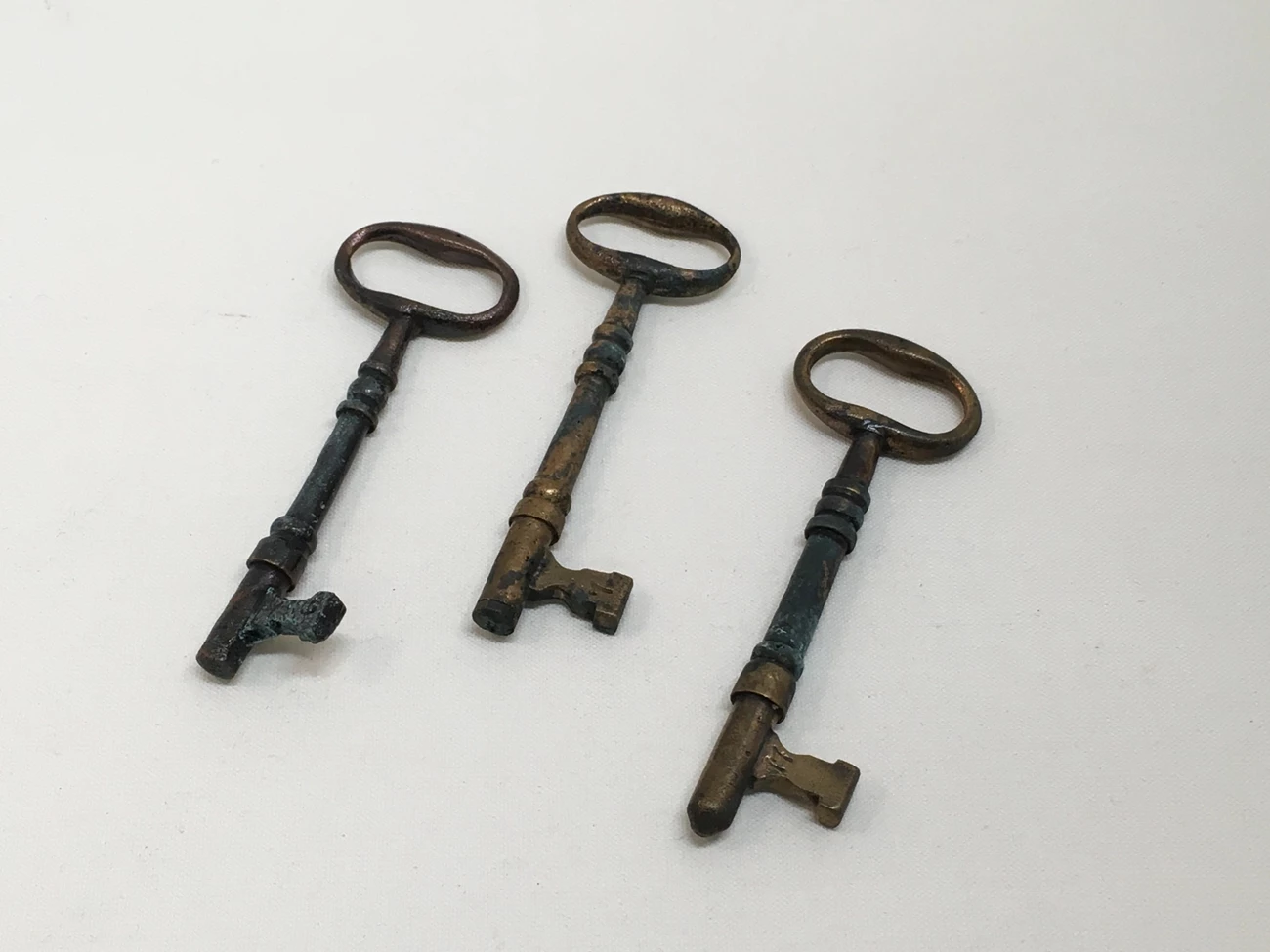Part of a series of articles titled Curious Collections of Fort Stanwix, The 19th & 20th Centuries.
Previous: Peter Gansevoort Portrait
Article

National Park Service

National Park Service
These brass keys may have once opened guest rooms in the stately 19th Century Stanwix Hall Hotel. (You can still read the room numbers stamped onto the keys!) This hotel, built in various stages in the 1840s, was among the structures torn down in the 1970s to accommodate the urban renewal project that included reconstruction of the fort. The Stanwix Hall Hotel welcomed visitors to Rome as the city flourished in the 19th and early 20th Centuries with the development of new and diverse industries (cheese, copper, and railroads among them). In 1878, Everts and Fariss wrote in The History of Oneida County, New York that “‘Stanwix Hall’ is announced on the arrival of trains at the depot to be the ‘principal hotel in the city’ and as the intelligent passenger hears its name spoken there are awakened in his mind memories of the days of ‘long ago’…”
The archeological excavation for the Willett Center found remains from the Stanwix Hall Hotel. The hotel privy was found in the rear yard of the hotel and its contents revealed a tremendous amount of information about life at the hotel in the second half of the nineteenth century.

National Park Service/Dick Ping Hsu
In 2003, the site of the Stanwix Hall Hotel was investigated for archeological resources. The hotel building itself had been destroyed in the 1970s in advance of the reconstruction of Fort Stanwix. The rear courtyard or work area was preserved and was the focus of the archeological study. The most important find at the Stanwix Hall Hotel site was the intact hotel privy. The privy was the dumping place for the contents of chamber pots, and for some of the hotel refuse.
Since the hotel was a four-to-five-story structure, the privy needed to hold a lot of nightsoil and garbage. And this privy could: it was twenty feet long, ten feet wide, and ten feet deep, built from cut and laid stone. A sample was taken from the privy from the top of the stone to the natural soil it was built on.
Even a privy as big as the one at the Stanwix Hall Hotel filled up and needed to be emptied. Usually, the contents were dug out and dumped away from the privy itself. In one instance, the contents did not make it very far and were left very close to the privy. The cleanout deposit was older than the contents of the privy when it was abandoned, showing the things that changed over time and the things that stayed the same.
Another use for privies? Trash and refuse disposal. In days where municipal services like trash removal were just being established, it might be costly or impossible to rid yourself trash. As a result, you can find broken dishes and bottles, buttons that popped off some unfortunate person’s clothing, and other items in them. It remains unknown as to why someone would purposely throw away a key. Perhaps it was dropped by accident while trying to avoid an "accident"?!

Image courtesy of the Rome Historical Society
The Stanwix Hall Hotel was built in 1844, the same year the enlarged Erie Canal was moved to the heart of Rome. This hotel served as one of the leading canal hotels in the city and was a center of community activity for decades.
In 1838, John A. Ford, the operator of the hotel at Barnard's Tavern, purchased a neighboring grocery property. The Stanwix Hall Hotel was built of brick between 1843 and 1844 on the site of Barnard's Tavern, the same year that the enlarged Erie Canal was moved to the City of Rome. In 1845, the hotel and adjoining properties were purchased. The roof was raised on the existing brick hotel, the older neighboring buildings torn down, and the hotel enlarged to encompass the corner of James and Whitesboro Streets.
Stanwix Hall Hotel was a persistent landmark at the corner of James and Whitesboro Streets until the 1970s. Other hotels including the Mansion House, Doyle's Hotel, the Luiera Hotel, and the Randolph Hotel were present at various times. The historic block was one of the main commercial areas of Rome offering services for travelers and merchants. The hotels and express offices are indicative of the importance of transportation in the development of Rome. This block was the central place for this type of development.
Hotels with a lobby, room service, and individual rooms for guests were a new invention in the early nineteenth century. Before about 1830, most travelers stayed in taverns if they needed public accommodation. The first hotel in the modern sense was the Tremont Hotel in Boston, which opened in 1829. Other true hotels opened shortly afterward and spread across New York in canal towns and elsewhere.
In 1900, the Stanwix Hall Hotel was the site of the presidential debate of William McKinley and Theodore Roosevelt against William Jennings Bryan and former Vice President Adlai Stevenson. McKinley and Roosevelt won the election and Theodore Roosevelt became president after McKinley was assassinated in 1901.

Image courtesy of the Rome Historical Society
Part of a series of articles titled Curious Collections of Fort Stanwix, The 19th & 20th Centuries.
Previous: Peter Gansevoort Portrait
Last updated: July 28, 2025